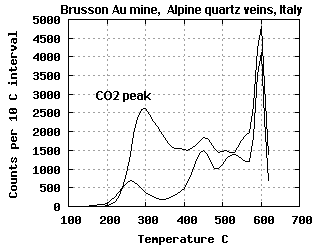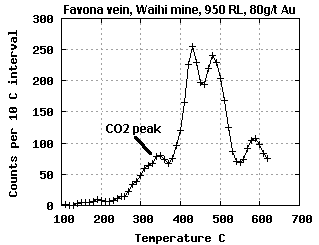GOLD EXPLORATION USING
FLUID INCLUSIONS
K. Burlinson
Burlinson
Geochemical Services, PO Box 37134, Winnellie, NT, Aust.
Despite our extensive understanding of fluid inclusions and
the importance of fluid systems in the formation of many economic
mineral deposits, there is negligible use of
this important data as an
exploration tool. The traditional methods
of fluid inclusion study are
tedious, slow and expensive and are unsuitable for
routine field data collection. However, by using baro-acoustic
decrepitation we can rapidly and economically collect
very useful inclusion data, albeit not as pedantically precise
as is used in research work. This
decrepitation data is particularly useful
in identifying the presence of CO2 rich inclusion fluids, which are
well known to be commonly associated with Au mineralisation.
Gas-rich fluid inclusions give a distinctive
low temperature decrepitation peak
because these inclusions have high
internal pressures at room temperature
and when heated, the pressure increases linearly with temperature
in accordance with the gas law. In contrast, aqueous fluid
inclusions have a condensed liquid phase and do not
generate high internal pressures until temperatures above
their homogenisation point.
Samples from the Waihi epithermal gold deposit, NZ, have been
analysed and they show low overall
decrepitation intensities, as
expected from epithermally formed fluid inclusions, but
they clearly show low temperature decrepitation indicating the
presence of CO2 rich fluid inclusions. There is a
useful correlation between the Au content of
the samples and the observed low temperature CO2
decrepitation measurements.
The Brusson mine in Italy is an alpine quartz vein
which has been mined since Roman times. Samples from
this mesothermal deposit have much more
intense decrepitation and a prominent low temperature CO2 peak,
as well as multiple other inclusion populations.
Baro-acoustic decrepitation can give valuable fluid inclusion
data to use in mineral exploration.
Many mineral deposits are “fossilized”
fluid systems and we can surely benefit by using fluid inclusion
information when exploring for them, not merely for
forensic analysis of the deposits we have
already found.
 Applied Mineral Exploration
Applied Mineral Exploration Discussion and research relevant to mineral
exploration.
Discussion and research relevant to mineral
exploration. 
